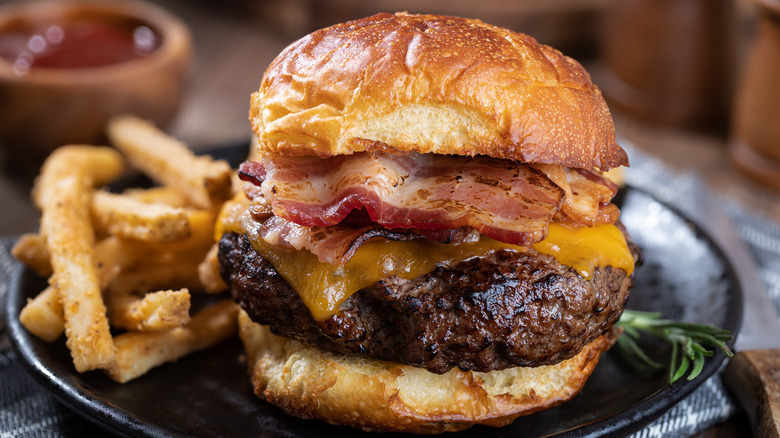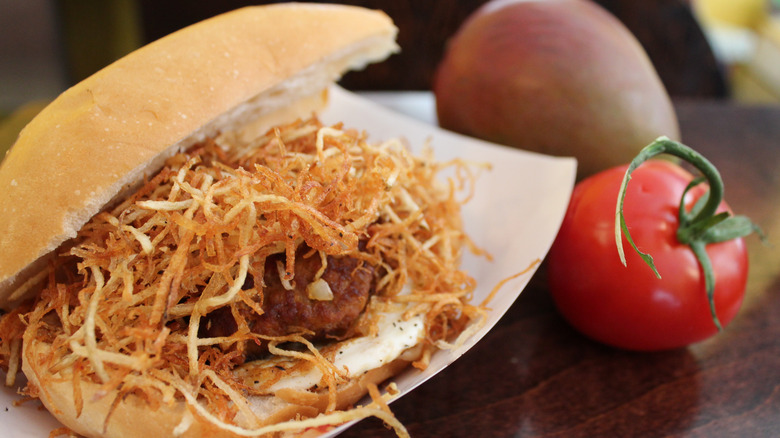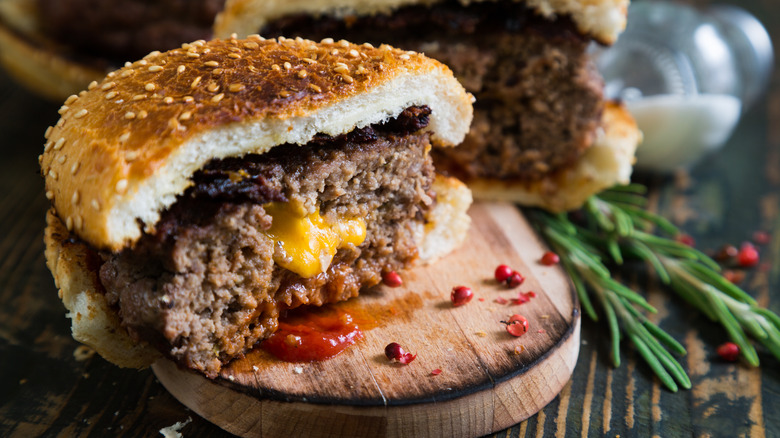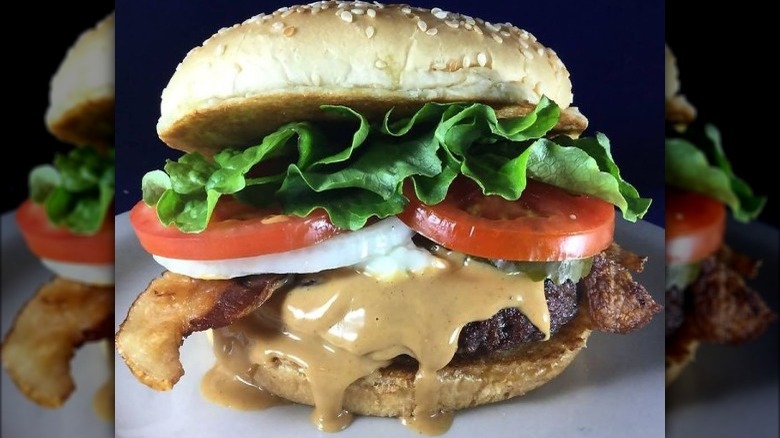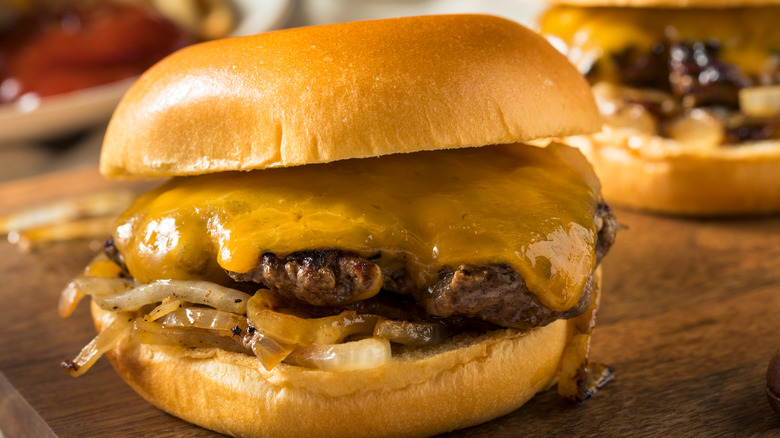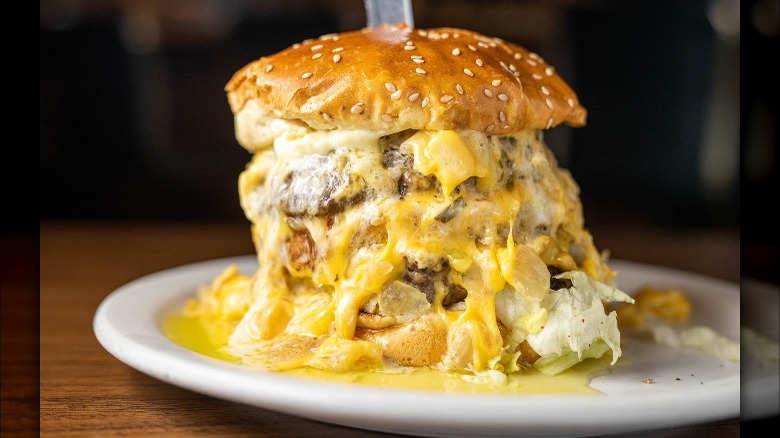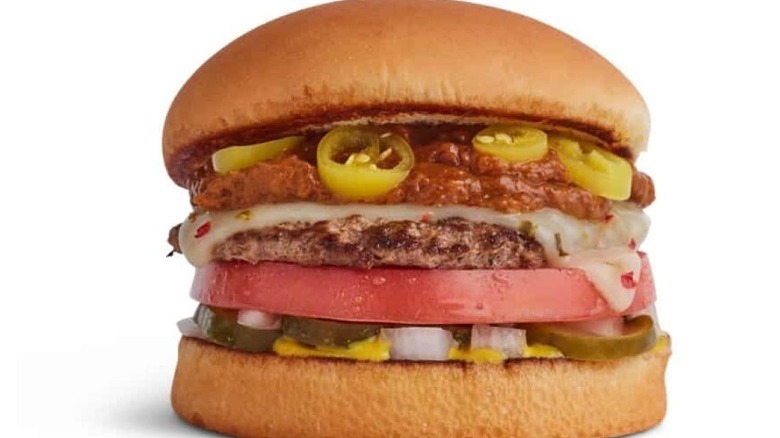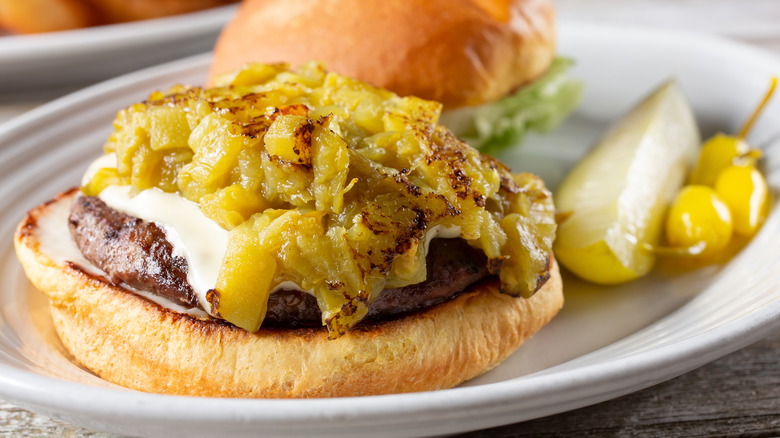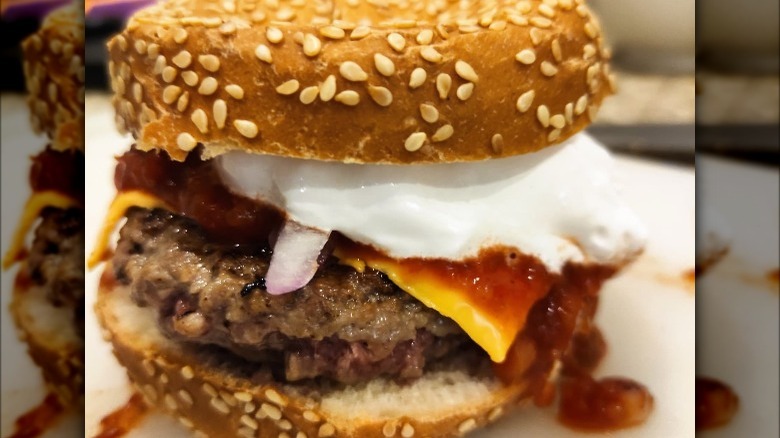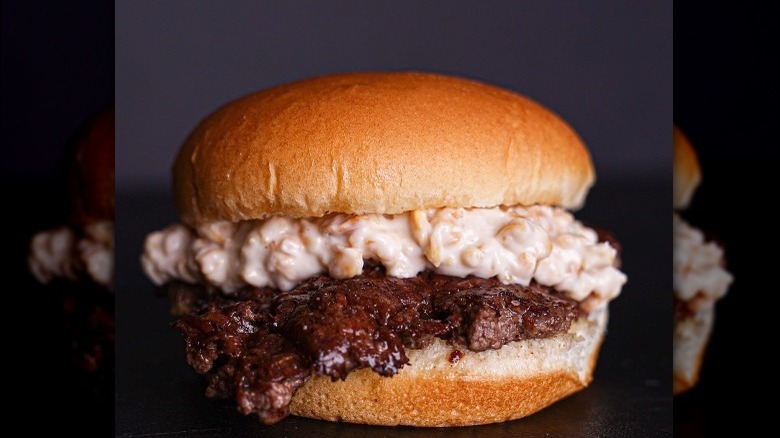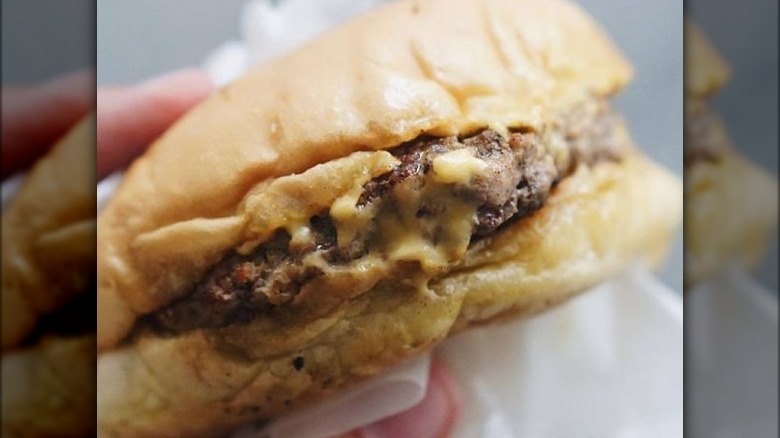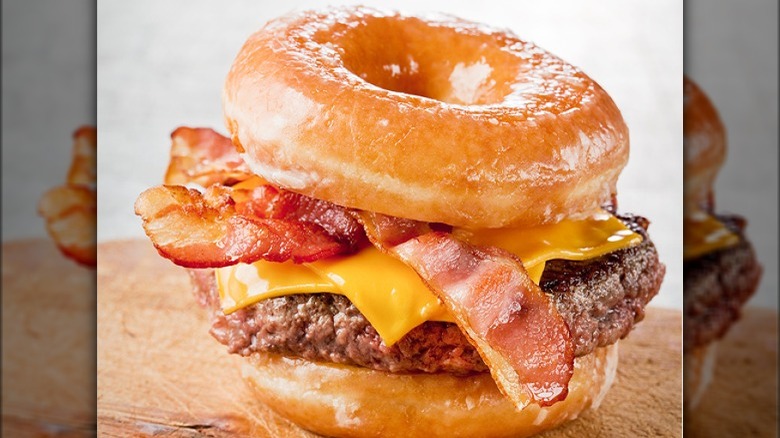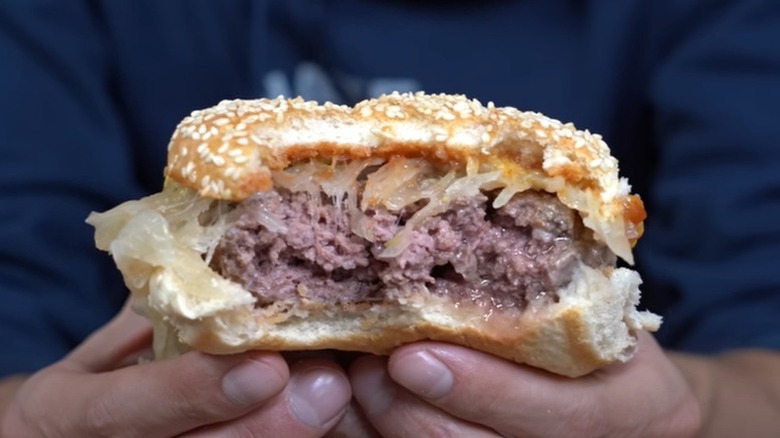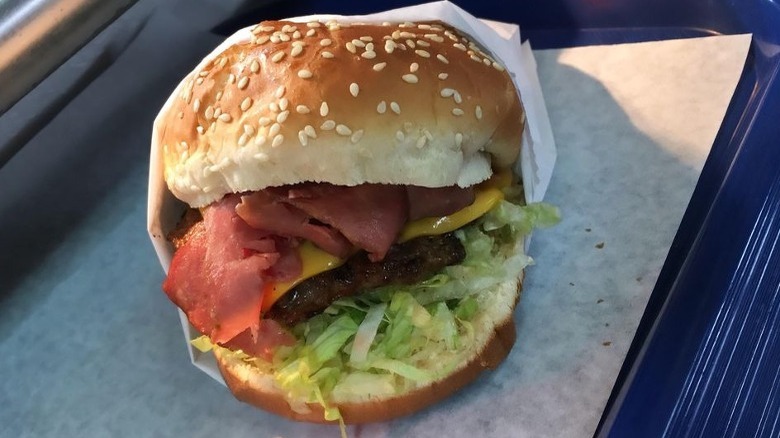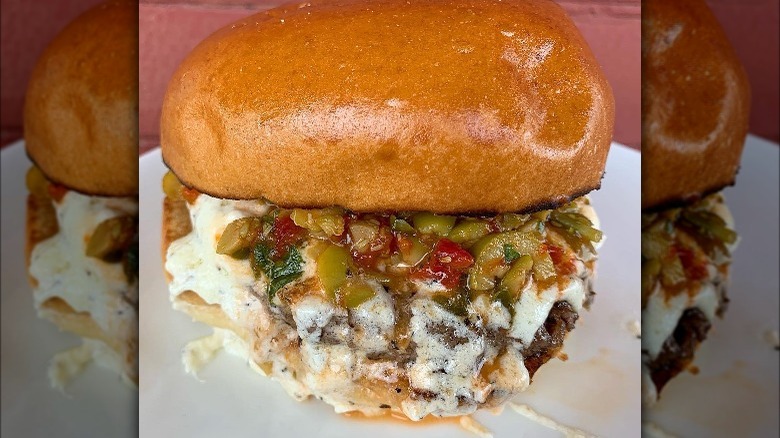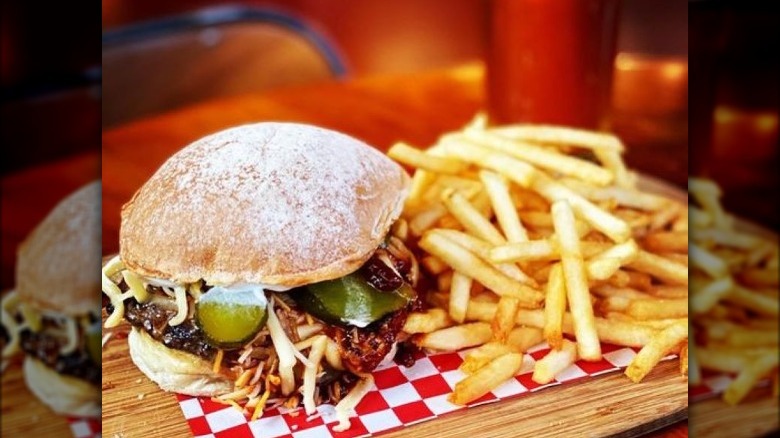Regional Burger Styles You Should Try
There are many American dishes that have questionable origins, but with the classic American burger, there is no doubt. Burger is the ultimate Americana dish born and shaped on U.S. soil. Though it went on to conquer the world — only rare cities in the world don't have at least one burger shop — it managed to build and retain the almost cult-like status in the American culinary narrative. As the burger tradition spread across the country, the process naturally resulted in numerous regional varieties.
Regional burger styles mainly evolved due to the abundance of local ingredients that were eventually partnered with other elements and implemented in the classic burger combination. However, some examples were merely a result of modified techniques that ultimately created a novel burger style. Of course, all regional burgers fit the local framework and were built to satisfy local tastes.
Some of these have long crossed their native state's borders, but several remain strictly confined to their birthplace and are virtually non-existent in other places in the U.S. Ideally, this list can be used as an inspiration for a food trail or your next food-inspired bucket list, but if you are not so lucky to experience all of these at the source, most are easily recreated at home, so have a go and pay homage to these regional burger icons.
Frita Cubana - Florida
The name Frita Cubana immediately suggests that this regional burger started its journey in Cuba, but despite its origin, it gained momentum and found its spiritual home in Florida. It is assumed that the first Cuban versions appeared in Havana at the beginning of the 20th century. They were originally sold by street vendors and were meant to act as a quick and convenient snack on the go. Eventually, it became a rarity in its homeland, but the burger style soon resurfaced in the States. The first frita shop was opened in 1961 by Dagoberto Estevil, with many others following suit.
The classic Cuban Frita in Miami will get you a well-seasoned beef patty nestled inside a Cuban roll and topped with onions and stringy fried potatoes. The variations will sometimes add pork or chorizo to the beef patty, and most versions will include a splash of tomato-based sauce that acts as an ideal condiment.
Juicy Lucy - Minneapolis
The Juicy Lucy is possibly the best-known regional burger variation on the list. This Minneapolis legend has been around for over 70 years and is probably the cheesiest burger ever created in the U.S. In its basic form, the Juicy Lucy consists of a thick beef patty stuffed with cheese. As the meat is grilled, the cheese heats up and melts, providing an oozing spectacle as you cut through the patty. This burger does not call for any elaborate additions or condiments, but fried onions are usually offered as an optional add-on, along with pickles.
As it's usually the case with these legendary dishes, the origin of Juicy Lucy is often disputed. It most certainly originated in Minneapolis, but two local joints can't seem to agree on who was the first to put it on the menu. The late Matt Bristol, who used to run Matt's Bar, claimed he made the original version and accidentally misspelled it without i — as "jucy." Another place often credited is the 5-8 Club, a local bar that can't precisely corroborate the person who first made it or when the dish was created. Regardless, this cheese-stuffed variation is the ultimate burger style in Minneapolis and should be on the list of every passionate burger aficionado.
Guberburger - Missouri
The Guberburger is a peanut butter burger from the small town of Sedalia, Missouri. It was created at a local burger joint called The Wheel Inn, which sadly no longer exists, but the legend of this unusual concoction lives on. Seemingly, the guberburger resembles your classic American burger. It consists of a bun topped with a beef patty and includes lettuce and tomatoes as typical garnishes. But that is where the standard ends. As it grills, the patty is smothered in melted peanut butter, while the top bun is coated with Miracle Whip, though mayonnaise is often used instead.
The Wheel Inn was a local joint whose story started in the 1940s, and the place closed in 2013. Despite the closure of the original site, some local restaurants continue to serve this regional specialty. The name guber, or goober, is one of the colloquial terms used as a reference for peanuts and derives from the African term n-guba, which translates as peanut.
Onion burger - Oklahoma
The onion burger from Oklahoma enjoys quite a good rep outside the state's border. And it is easy to understand why it became such a coveted combination. This burger stands out not only for the addition of onions but the cooking technique, which dictates that onions are nestled under the patty as it grills, allowing the meat and caramelized onion to blend into a perfect medley. The burger is made with a classic bun, and American cheese is the only additional element in this combo, though pickles and a touch of mustard are not considered blasphemous.
The local lore claims that the onion burger first appeared in the local joints sometime in the 1920s, during the Great Depression. The onions were supposedly added to the patty to stretch the meat during these difficult times, but it proved to be a winning combination as it managed to stay relevant a century later and is still one of the must-try specialties in Oklahoma.
Butter burger - Wisconsin
The butter burger is an original Wisconsin creation. Though the term can denote a burger where butter has been added to the patty, for the Wisconsinites, it means that the sandwich has been topped with a generous slab of butter. As the burger is still steaming hot, the butter will melt on the sides, creating a buttery puddle at the bottom of the chunky burger.
Wisconsin is known for its milk products, so we are not surprised that the butter burger originated in the state affectionately called the Dairyland. Most agree that the first butter burger was dished out in 1936 at Solly's Grille, when this Milwaukee location was still known as Solly's Coffee Shop. You can still have the original butter burger at Solly's, where they serve it on a toasted bun and with a heap of stewed onions, but the combo is not exclusively made here. You can easily find renditions of the classic butter burger in numerous other diners and burger joints, though the word is that the amount of butter used at Solly's is unparalleled. The place was even crowned as one of America's Classics by the James Beard Foundation.
Chili burger - California
As its name suggests, this sloppy regional variety uses chili as the star ingredient inside the burger. Though there is consensus that the chili burger was invented in California, there are several accounts of who was the first to introduce it to the public. Though some reference the old and non-operational Ptomaine Tommy's as the first who made the chili-covered burger, most agree that the title belongs to the Original Tommy's, a local institution opened in 1946 by Tom Koulax.
What started as a single shack in Los Angeles soon expanded into a local chain currently operating in approximately 30 locations throughout California and Nevada. Tommy's popularity is best seen in the fact that many still try to imitate it by using similar names and décor that tries to replicate the original. The LA Times covered the story in 2019, and at the time, 67 locations in Los Angeles County used a similar name and approach, possibly trying to copy the original. A chili burger is your classic beef patty burger served with a ladle of beef chili. Perhaps it is not the prettiest burger on the list, but it is certainly one of the more extravagant variations.
Green Chile Cheeseburger - New Mexico
Do not confuse the green chile burger from New Mexico with the previous chili burger. The New Mexican version stands out for the sweet and spicy roasted green chiles stacked inside the bun.
New Mexico is known for its chile peppers, especially the ones harvested in the Hatch Valley. The first local strains were developed in the 19th century, and the chiles now present a vital regional cultivar that is an integral part of the local economy. As the peppers have such a long history in the state, it's only logical that they were eventually added to burgers. It is estimated that the first versions appeared sometime in the 1920s following the opening of Route 66, and the place mostly labeled as the original location is the Owl Bar and Café, located in San Antonio. Allegedly, the custom was to order some chile on the side with the burger order, but due to a lack of clean dishes, the peppers were added directly to the burger, and the tradition has stuck ever since.
This is a cheeseburger with a flexible list of ingredients, so expect to find numerous variations and regional sub-styles, with each burger joint dishing its signature version. However, beef patty, gooey cheese, and smoky peppers are the essentials.
Fluff screamer - Pennsylvania
The name of this variation can easily indicate the quirky ingredient that makes this burger unique. If you haven't guessed already, this burger uses the feather-light marshmallow spread — Fluff being the most popular version, whose name is sometimes colloquially used for other varieties — as a garnish on top of the patty. The screamer part of the name is inspired by the inclusion of chili paste.
The original elements inside the screamer include a burger patty, sliced onion, a heap of house-made spicy sauce, some butter, cheese, and a dollop of marshmallow spread. The combination was invented at Tony's Lunch, an unassuming burger joint in Girardville, Pennsylvania. The place has been operating since the 1940s, and though it changed hands from the original proprietors, it still bears the name of its founder. Tony's Lunch is best known for its quirky invention that was allegedly inspired by a local teen who continually asked for marshmallow cream on the burger. Her request was initially rejected, but the servers eventually agreed to proceed with the order, and the combo unexpectedly became a customer favorite and local tradition.
Nutburger, Montana
If you try looking up the nutburger, the result will be dominated by a long list of burgers that use nuts as the base for the patty. However, the nutburger from Montana is an entirely different beast with nothing to do with plant-based nutburger varieties.
The one from Montana features a classic beef patty tucked inside a burger bun, and though it sounds like any other beefy burger, it stands out for its unique garnish sauce that combines crushed peanuts and Miracle Whip. The nutburger was created at Matt's Place, the unpretentious local spot in Butte, Montana that was opened in 1930 by Matt Korn. The place changed owners — but it kept its name and the old-school allure with the classic menu and the charming vintage décor. Sadly, the restaurant is now permanently closed, but the legend of the quirky nutburger lives on, and we are optimistic that someone will take over and continue to whip up Matt's legendary burgers.
Steamed cheeseburger - Connecticut
Though this list is filled with burger combos that might have you lost for words, this might be the most controversial item you'll find. A burger that is not grilled? Apparently, this is an entirely acceptable idea, and how they roll in central Connecticut, where steamed burgers first gained momentum.
Sometimes referenced as a cheeseburg, this steamed burger does not diverge much from the classic version, at least regarding the ingredients. The typical cheeseburg will consist of a soft burger bun topped with a beef patty, all adorned with a slice of melted steamed cheese. The sandwich is topped with lettuce, tomato, and optional garnish, and the whole thing is locked with a top side of the bun. The patties for this burger are steamed in special containers where the meat is suspended over water. As the steam is released, the patties are slowly cooked. Though this burger misses out on the charred, caramelly bits, it does compensate with incredible juiciness and concentrated flavors. It is also worth mentioning that it is by far the healthiest burger preparation technique.
Luther burger - Georgia
The Luther burger is an over-the-top version that uses doughnuts instead of the classic burger bun. Usually, hefty Krispy Kreme glazed doughnuts make the base, but a classic butter-enriched brioche is sometimes used instead. The remaining ingredients inside the Luther are traditional: a grilled beef patty, a slice or two of American cheese, and some crispy fried bacon.
The origin of the Luther burger is still not entirely clear. A popular legend says that the famous R&B singer Luther Vandross was the first to think of the combo, but this information has never been corroborated. Paula Deen was also credited as the inventor, but as her sons confirmed, Deen first saw the recipe at a Minor League Baseball event and then recreated it on TV. The most likely version attributes the invention to Mulligan's Bar in Georgia, which also served the strange burger-hot dog beast called the hamdog until the restaurant closed in 2006.
Poached burger - Wisconsin
Apart from the luscious butter burger, Wisconsin has another regional variation that is fit for this list. As the name suggests, this is a burger version in which the patty is poached, but unlike the classic poaching technique in which the ingredients are dropped into boiling water, this is a slightly different method that does not plunge the whole patty into liquid. Instead, the patty is fried in a pan, and just a little bit of water is added to cook and fry simultaneously. Apart from water, some restaurants will use broth for an additional flavor kick.
Poached burgers are a tradition in Wisconsin that probably started at local fairs. The method proved ideal for keeping the burgers nice and warm between orders. This is a simple burger, and apart from the meat, it is usually dressed with plenty of stewed onion, though you can leave them out. Ketchup and mustard are the standard condiments.
Pastrami burger - Utah
The pastrami burger is a regional style that adds thinly sliced pastrami to the traditional burger combination. Typical ingredients inside the pastrami burger include a classic grilled beef patty topped with tomato, lettuce, and cheese, all smothered in another local favorite — the legendary fry sauce that combines mayo and ketchup, sometimes with the addition of other condiments. A generous amount of sliced pastrami is stacked on top, resulting in a rather bulky and hefty burger.
Though the origin of this local favorite is shrouded in mystery, Nick Katsanevas from Crown Burgers is usually credited as the inventor and the person who put Utah on the American burger map. Katsanevas probably introduced the pastrami burger sometime in the 1970s, and Crown remains the must-visit burger chain that still whips up probably the best pastrami version. Despite the claims that Southern California is the true home of this burger, this dish is now closely associated with Utah and is regularly lauded as the local specialty.
Olive burger - Michigan
The Midwest has its fair share of quirky food combinations — just think of Watergate salad, a sweet dish that combines marshmallows, pecans, and pineapple — and this burger is no different. As you may guess from the name, olives are the star ingredient in this burger combo. The dish is assembled on a classic burger bun and made with a standard beef patty that is grilled until it's caramelized. The sandwich usually includes cheese and mayonnaise, and the final touch is a garnish made with a heap of chopped olives stacked on top of the meat. Olive brine is also often added to the burger and used as a sauce-like condiment, sometimes mixed with mayonnaise.
The Michigan-style olive burger most likely originated in Flint, but these days Lansing — which hosts the annual olive burger festival — and Grand Rapids seem to be the go-to places to get the best version of this local specialty. Though the olive-burger combination might sound strange, the flavors probably work together as the burger remains an ultimate favorite among the locals. It is worth mentioning that the version of an olive burger from Weston's Kewpee was crowned as best in the show at a Miami burger festival, so there has to be something more to it than merely local pride.
Theta burger - Oklahoma
Oklahoma's contribution to the list of American regional burgers is a simple, unpretentious burger that combines a typical beef patty with shredded cheese and pickles. The condiments include mayonnaise as the classical option and hickory sauce as a proper local addition that turns this burger into a regional specialty you will probably only find in Oklahoma. The sauce will give the burger that classic smoky note reminiscent of BBQ flavor and aroma.
Like many other burgers on the list, it is difficult to pinpoint where and when this burger originated, but it has been a staple in the region for decades. The most popular local lore says that the first version was assembled sometime in the 1930s at the Town Tavern in Norman, Oklahoma. Allegedly, the owner Ralph Geist wanted to speed up the ordering process for the Kappa Alpha Theta sorority members by creating a burger with set ingredients, and also pay homage to his customers.
